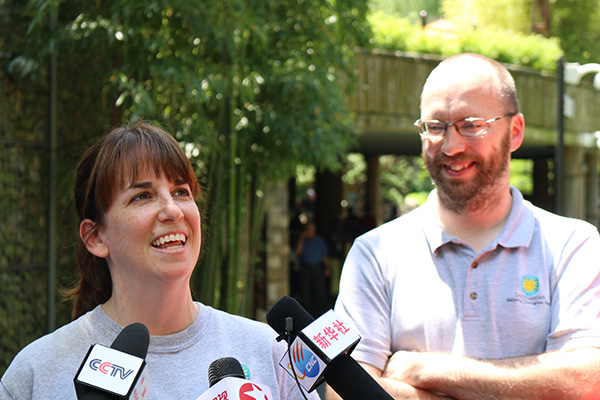The pandas are all right, zoo says
 |
|
Laurie Thompson (left), assistant curator of giant pandas at the Smithsonian National Zoo, and Marty Dearie, giant panda keeper, talks to media on Wednesday that the bears are faring well following panda mom's estrus and the cub's weaning. ZHAO HUANXIN / CHINA DAILY |
"We've weaned two cubs prior to Bei Bei at 18 months (of age), and they've done very well, and so we've weaned Bei Bei, and he is as well doing very well," Dearie said.
"The cub is ready on his own, and the mother is potentially looking to have another baby."
Laurie Thompson, assistant curator of giant pandas at the zoo, also said the bears are not social animals; they tend to live by themselves.
"So he has to be comfortable finding his own food, occupying his own time seeking out food and doing the things he needs to do," she said. "He can't do that if mom is always with him."
As to the panda mother, Mei Xiang is given around 24 kilograms of bamboo overnight, which is more than enough, Thompson said.
"So the food amount doesn't change, but during the period of time when she goes estrus (in heat), the male and female reduce their food intake," she said. "We still give them food, but they just get very restless."
Pandas naturally encounter snakes in the wild. Besides, the snakes found in Mei Xiang's closure are not poisonous, so she won't be harmed, Thompson said.
As many netizens watch the 24/7 panda cameras installed at the zoo, Pamela Baker-Masson, associate director of communications and exhibits, said the zoo couldn't interpret around the clock to viewers what is happening, which could sometimes cause misunderstanding.
"It will be remarkable if we could have Bryan spend 24 hours interpreting on the panda cam: 'Now the panda is doing this; now the panda is doing that.' We are just not able to do that," she said.
"We believe that the vast majority of our viewers understand and trust that they are doing really, really well in our care."
The first pair of pandas arrived at Washington 45 years ago. With 12 now living in Washington, Atlanta, San Diego, California, and Memphis, Tennessee, the US has the most giant pandas outside China.
Yuan Yuan in Washington contributed to this story.
huanxinzhao@chinadailyusa.com




















